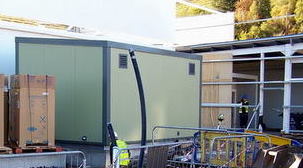Tesco chooses ICAX's Interseasonal Heat Transfer™ for new store at Greenfield, Oldham
Interseasonal Heat Transfer has been chosen as the sustainable heating and cooling source for the new supermarket at Greenfield, near Oldham, which opened on 6 December 2010.
Interseasonal Heat Transfer
The ICAX design for Interseasonal Heat Transfer at Greenfield provides cooling in summer by extracting heat from the supermarket and, instead of blowing this into the atmosphere like an air conditioning chiller, ICAX stores the heat in ThermalBanks in the ground.
When heating is needed in winter the ICAX system extracts the stored heat from the Thermalbank using a ground source heat pump and distributes it within the building. This recycling of waste heat through the Thermalbank, allows ICAX to deliver a significantly higher coefficient of performance than would be achieved by a traditional “unassisted GSHP”.

ICAX Skid arrives at TESCO Greenfield - 20 October 2010
Energy Management System recycles thermal energy
The Energy Management System within the ICAX Skid looks at the most cost effective energy source at any given time, and enables the transfer of heat from where it is available most easily to the areas of the building that need heat. If heat is not available from these sources the system looks to extract heat from the ThermalBank using a ground source heat pump. The natural energy system also has access to an air source heat pump for those spring days when the external air temperature is rising and the heat store in the ground is depleted at the end of the heating season. The ICAX Skid uses an intelligent approach to save energy and re-cycle heat whenever an opportunity arises.
Tesco's commitment to saving energy
The IHT scheme underlines Tesco's commitment to saving energy and lowering its carbon emissions.
These are significant commitments from a large organisation and Tesco is continuously exploring the ways in which it can reduce the carbon footprint of its stores.
As a global business Tesco recognises an important role in helping to minimise climate change. With the overarching goal to be a zero-carbon business by 2050, Tesco follows a three-part climate change strategy and has set the following goals for its built estate:
- becoming a zero-carbon business by 2050
- halve emissions from its 2006 baseline portfolio of buildings by 2020
- new stores built between 2007 and 2020 to emit half the CO2 of a 2006 new store
Tesco reduces carbon emissions by 41%
The ICAX design of Interseasonal Heat Transfer for Tesco's Greenfield Store is designed to reduce carbon emissions from heating and cooling by 41% compared to a conventional store. ICAX achieves this by Energy Recycling.
IHT and RHI reduce annual running costs to zero
The efficient use of energy by IHT is estimated to reduce the annual cost of heating and cooling the supermarket by 40%. The subsidy from the Renewable Heat Incentive is expected to reduce the annual running cost (including maintenance) to less than zero.
See also: IHT Systems Design
See also: Renewable Heat Incentive
See also: Renewable Cooling
See also: District Heating using IHT
See also: Banking on IHT | The Merton Rule | Clean Energy Cashback
See Ground Source Heating See Ground Source Cooling See Ground Source Energy



